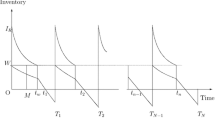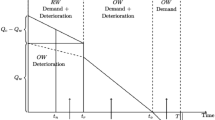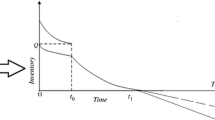Abstract
In realistic world, there usually exist various factors that induce the retailer to order more items than the capacity of his Own-warehouse (OW). Therefore, for the retailer, it is very practical to determine whether or not to rent other warehouse and what order policy to adopt if other warehouse is indeed needed. For the stock dependent demand pattern, retailer has his own warehouse to display the items and may hire another warehouse of the larger capacity, treated as rented warehouse (RW) to storage the excess inventory. In this paper, an inventory model with power form stock-dependent demand rate is developed. The demand rate is assumed to be a polynomial form of current inventory level in Own-warehouse. It is also assumed that retailer first fulfills the demand (depending upon the stock displayed in the OW) directly from the RW until the inventory level in the RW reaches to the zero level, after that, demand is fulfilled from OW. As a consequence, no item is transferred from RW to OW, therefore no transfer cost (neither fixed nor variable) is considered between RW and OW. It is considered that the deterioration rate per unit items in the RW and OW are different due to different preservation environments, as a consequence the holding costs per unit item in RW and OW are also different. Proposed model is illustrated with some numerical example along with some sensitivity analysis of parameters.




Similar content being viewed by others
References
Balkhi, T.Z., Benkherouf, L.: On an inventory model for deteriorating items with stock dependent and time varying demand rates. Comput. Oper. Res. 31, 223–240 (2004)
Balakrishnan, A., Pangburn, M.S., Stavrulaki, E.: Stack them high, let 'em fly": Lot-sizing policies when inventories stimulate demand. Manag. Sci. 50(5), 630–644 (2004)
Bhunia, A.K., Maiti, M.: A two-warehouse inventory model for deteriorating items with a linear trend in demand and shortages. J. Oper. Res. Soc. 49, 287–292 (1998)
Chang, J., Dye, C.Y.: An EOQ model for deteriorating items with time varying demand and partial backlogging. J. Oper. Res. Soc. 50, 1176–1182 (1999)
Datta, T.K., Pal, A.K.: A note on an inventory model with inventory-level-dependent demand rate. J. Oper. Res. Soc. 41(10), 971–975 (1990)
Datta, T.K., Paul, K., Pal, A.K.: Demand promotion by up-gradation under stock-dependent demand situation—a model. (Int. J. Prod. Econ. 55, 31–38 (1998)
Dave, U.: On the EOQ models with two levels of storage. Opsearch 25, 190–196 (1988)
Dave, U., Patel, L.K.: (T, Si) policy inventory model for deteriorating items with time proportional demand. J. Oper. Res. Soc. 32, 137–142 (1981)
Deb, M., Chaudhuri, K.S.: An EOQ model for items with finite rate of production and variable rate of deterioration. Opsearch 23, 175–181 (1986)
Dye, C.Y., Ouyang, L.Y., Hsieh, T.P.: Deterministic inventory model for deteriorating items with capacity constraint and time-proportional backlogging rate. Eur. J. Oper. Res. 178(3), 789–807 (2007)
Ghare, P.M., Schrader, G.H.: A model for exponentially decaying inventory system. (Int. J. Prod. Econ. 21, 449–460 (1963)
Ghosh, S.K., Khanra, S., Chaudhuri, K.S.: An inventory model for a deteriorating item with two levels of storage and stock-dependent demand. Int. J. Math. Oper. Res. 3(2), 186–197 (2011)
Hartely, V.R.: Operations research—a managerial emphasis, pp. 315–317. Good Year, Santa Monica (1976). Chapter 12
Hsieh, T.P., Dye, C.Y., Ouyang, L.Y.: Determining optimal lot size for a two-warehouse system with deterioration and shortages using net present value. Eur. J. Oper. Res. 191, 182–192 (2008)
Kar, S., Bhunia, A.K., Maiti, M.: Deterministic inventory model with two levels of storage, a linear trend in demand and a fixed time horizon. Comput. Oper. Res. 28, 1315–1331 (2001)
Pakkala, T.P.M., Achary, K.K.: A deterministic inventory model for deteriorating items with two warehouses and finite replenishment rate. Eur. J. Oper. Res. 57, 71–76 (1992)
Roy, A., Maiti, M.K., Kar, S., Maiti, M.: An inventory model for a deteriorating item with displayed stock dependent demand under fuzzy inflation and time discounting over a random planning horizon. Appl. Math. Model. 33(2), 744–759 (2009)
Sajadieh, M.S., Thorstenson, A., Jokar, M.R.A.: An integrated vendor-buyer model with stock-dependent demand. Transport. Res. E Logist. Transport. Rev. 46(6), 963–974 (2010)
Sarma, K.V.S.: A deterministic order-level inventory model for deteriorating items with two storage facilities. Eur. J. Oper. Res. 29, 70–72 (1987)
Singh, S.R., Singh, C., Singh, T.J.: Optimal policy for decaying items with stock-dependent demand under inflation in a supply chain. Int Rev Pure Appl Math 3(2), 189–197 (2007)
Singh, S.R., Singh, C.: Two echelon supply chain model with imperfect production, for Weibull distribution deteriorating items under imprecise and inflationary environment. Int. J. Oper. Res. Optim. 1(1), 9–25 (2010)
Teng, J.T., Chang, C.T.: EPQ model for deteriorating items with price and stock-dependent demand. Comput. Oper. Res. 31, 297–308 (1995)
Teng, J.T., Chang, C.T.: Economic production quantity models for deteriorating items with price and stock dependent demand. Comput. Oper. Res. 32, 297–308 (2005)
Teng, J.T., Ouyang, L.Y., Cheng, M.C.: An EOQ model for deteriorating items with power-form stock-dependent demand. Inform. Manag. Sci. 16(1), 1–16 (2005)
Vishnoi, M., Shon, S.K.: Two levels of storage model for non-instantaneous deteriorating items with stock dependent demand, time varying partial backlogging under permissible delay in payment. Int. J. Oper. Res. Optim. 1(1), 133–147 (2010)
Wu, K.S., Ouyang, L.Y., Yang, C.T.: An optimal replenishment policy for non-instantaneous deteriorating items with stock-dependent demand and partial backlogging. Int. J. Prod. Econ. 101, 369 (2006)
Yang, H.L.: Two-warehouse partial backlogging inventory models for deteriorating items under inflation. Int. J. Prod. Econ. 103, 362–370 (2006)
Author information
Authors and Affiliations
Corresponding author
Appendix
Appendix
Proof of Theorem 1: For the sake of convenience, let us suppose that
The graphs of the f(q) and g(q) are given in Fig. 5.
For single warehouse inventory system, it is seen that the optimal quantity q* for TP(q) to be maximum satisfies
Since M ≥ 0, we have
from Eqs. 31 and 32 and the Fig. 5, we can easily observe that q* ≥ W. in contrast, if W ≤ q*, it can also be easily seen from Fig. 5 that f(W) ≥ g(W), i.e. M ≥ 0. This completes the proof of theorem 1.
Proof of Theorem 2: We have from Eq. 27
By the necessary condition of optimality, the optimal value of \( T_r^{ * } \) of Tr for the maximization of TP2(Tr), must satisfy \( \frac{{d\left[ {T{P_2}\left( {{T_r}} \right)} \right]}}{{d{T_r}}} = 0 \). For assuring the existence of \( T_r^{ * } \), we first differentiate \( \frac{{d\left[ {T{P_2}\left( {{T_r}} \right)} \right]}}{{d{T_r}}} \) with respect to T r i.e. \( \frac{{{d^2}\left[ {T{P_2}\left( {{T_r}} \right)} \right]}}{{dT_r^2}} \).
For the maximization of TP 2(T r ), \( \frac{{{d^2}\left[ {T{P_2}\left( {{T_r}} \right)} \right]}}{{dT_r^2}} < 0 \), for the optimal value \( T_r^{ *}\;of\;{T_r} \). Hence \( T_r^{ * } \) is the global maximum point of TP2(Tr) in the interval (0, T) when M ≥ 0.
Proof of Theorem 3: Based on results of theorem (2), the average total profit function reaches its maximum at the point \( {{\mathrm{T}}_{\mathrm{r}}} = T_r^{ * } \) in the interval [0, T] if M ≥ 0. This indicates that when M ≥ 0, the maximum average total profit \( T{P_2}({T_r}) \), for the inventory system with two warehouse should be greater than \( T{P_2}(0) \). From Eqs. 9 and 27, we see that \( T{P_2}(0) = T{P_1}(W) \).
Thus, \( T{P_2}(T_r^{*}) > T{P_1}(W),\,if\,M \geqslant 0. \)
From theorem (1), the optimal ordering quantity q*, of the single-warehouse system is greater than or equal to W when M ≥ 0. Therefore, for single-warehouse inventory system with capacity restriction, the optimal ordering quantity q* = W, and the corresponding maximal average profit is TP1(W). Hence it concludes the theorem.
Rights and permissions
About this article
Cite this article
Singh, C., Singh, S.R. Optimal ordering policy for deteriorating items with power-form stock dependent demand under two-warehouse storage facility. OPSEARCH 50, 182–196 (2013). https://doi.org/10.1007/s12597-012-0105-2
Accepted:
Published:
Issue Date:
DOI: https://doi.org/10.1007/s12597-012-0105-2





